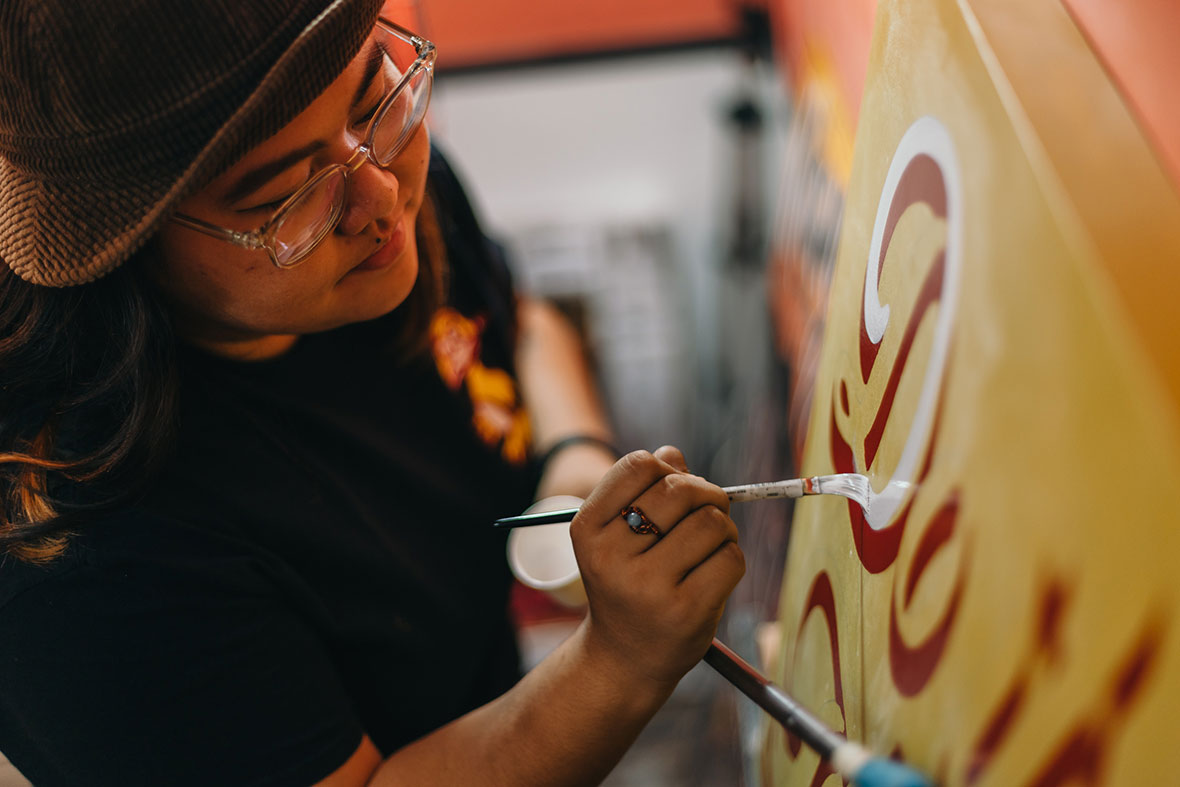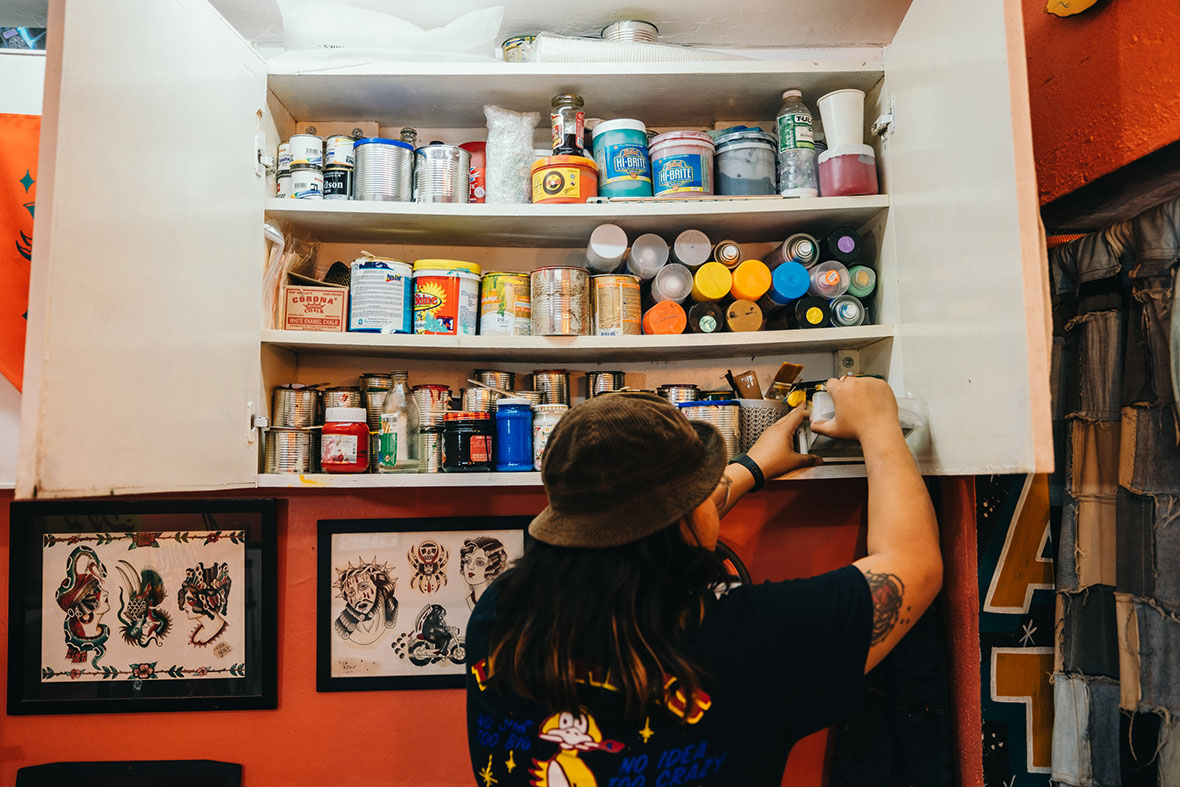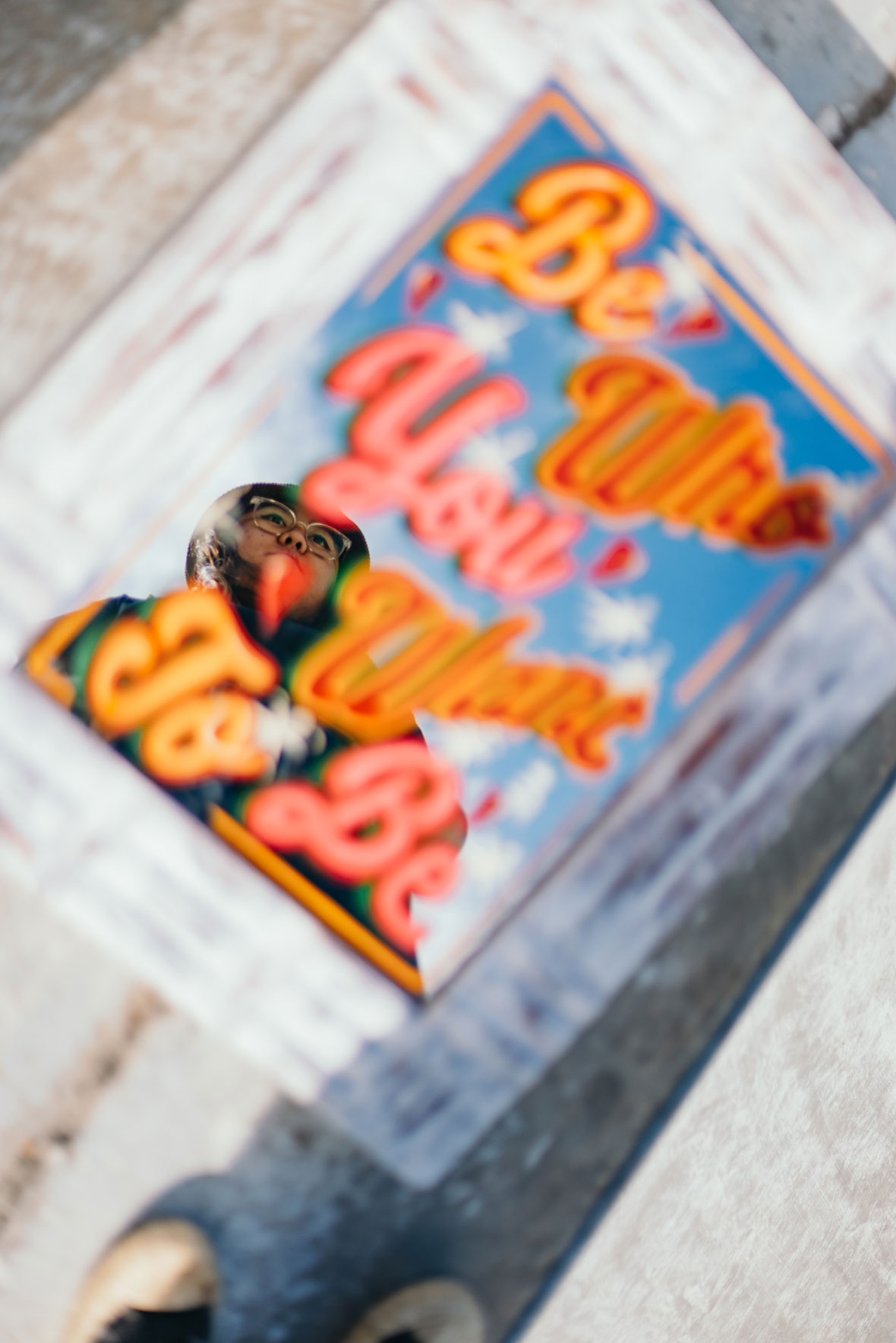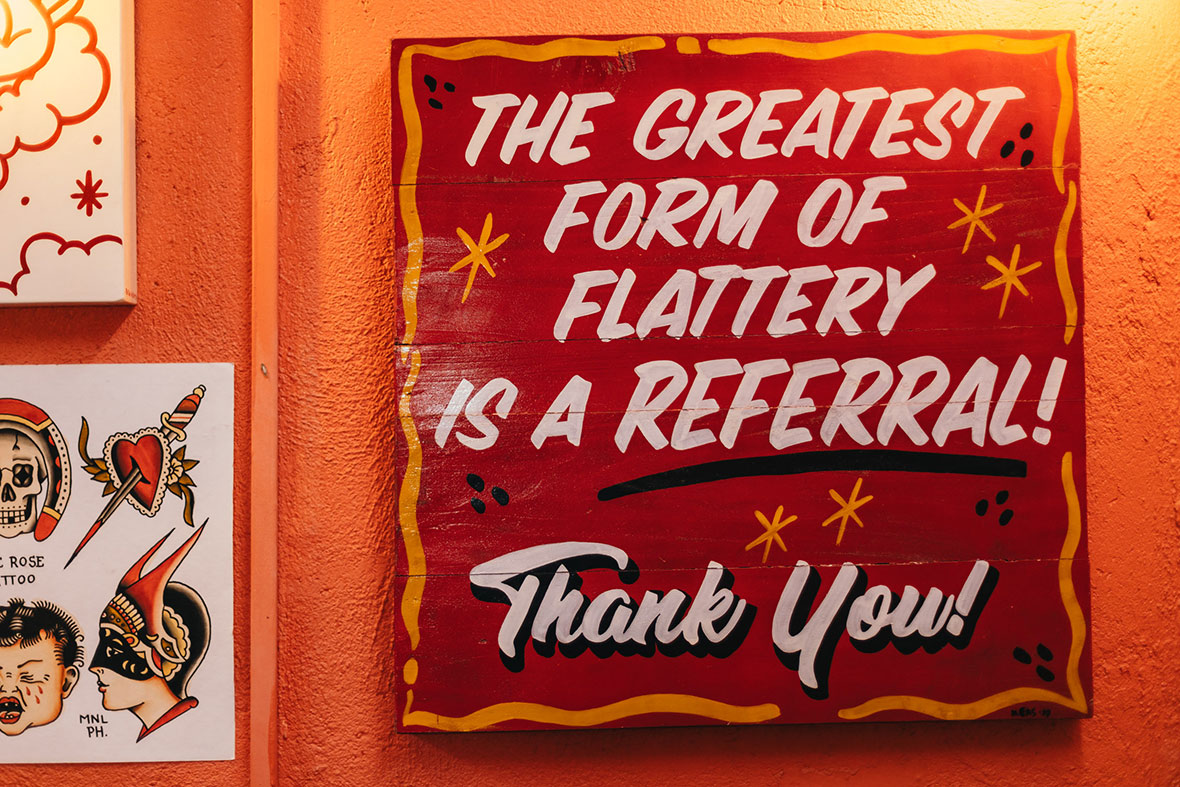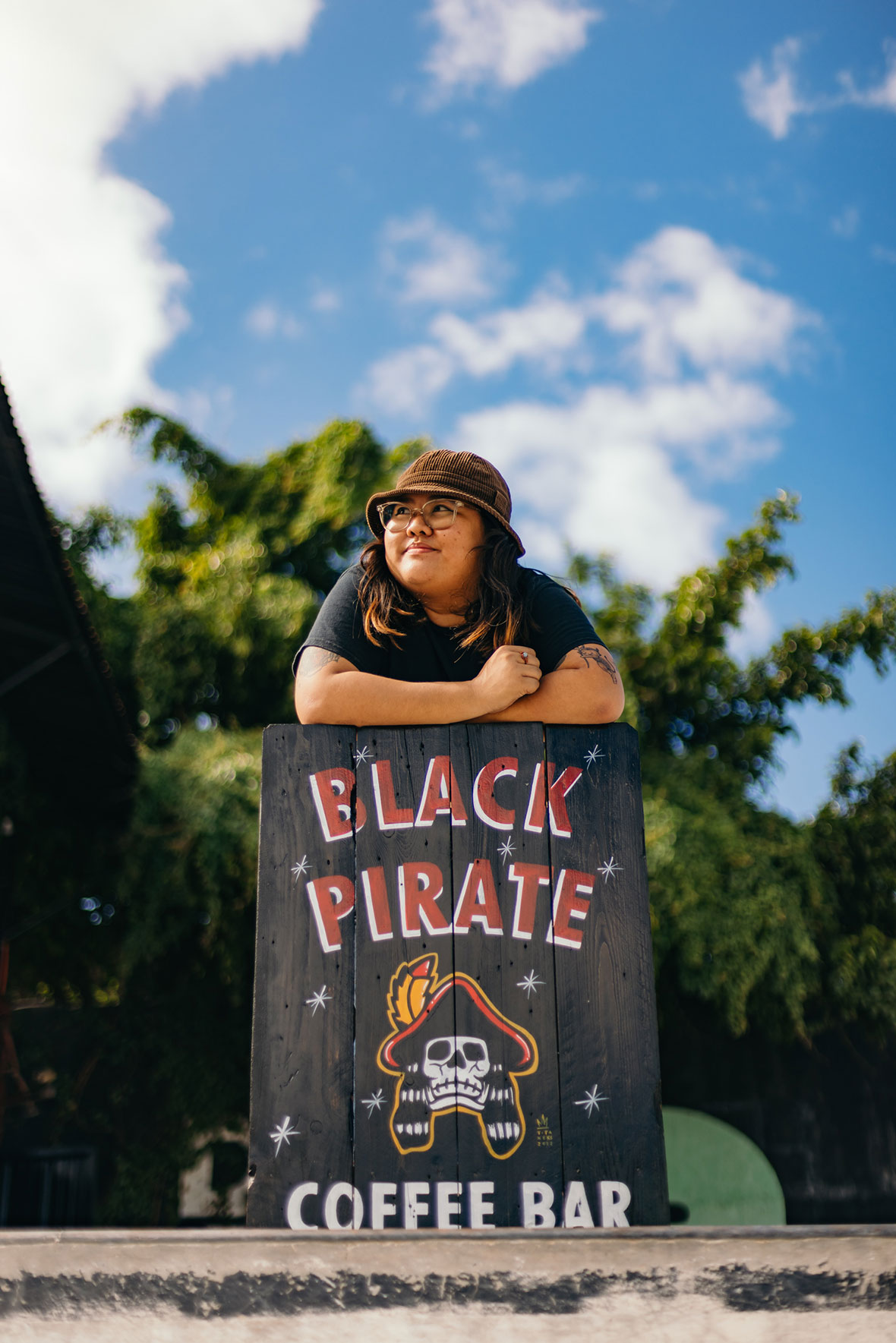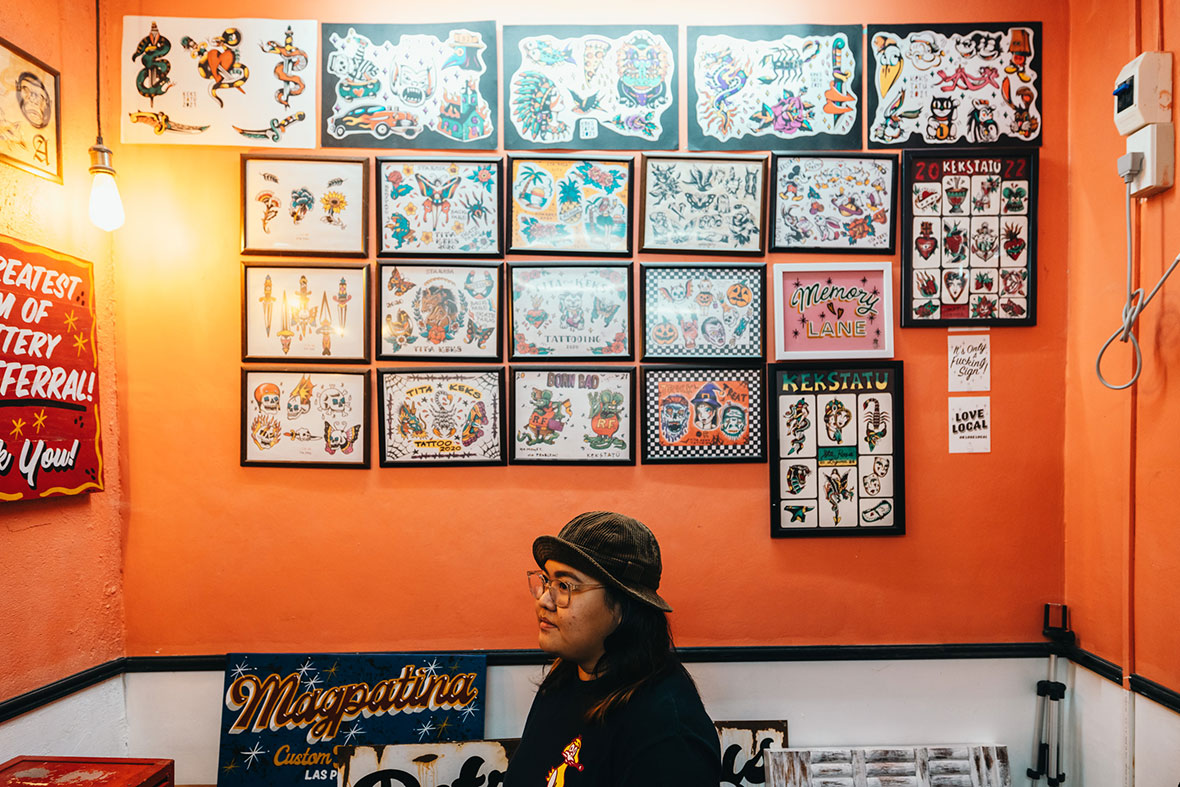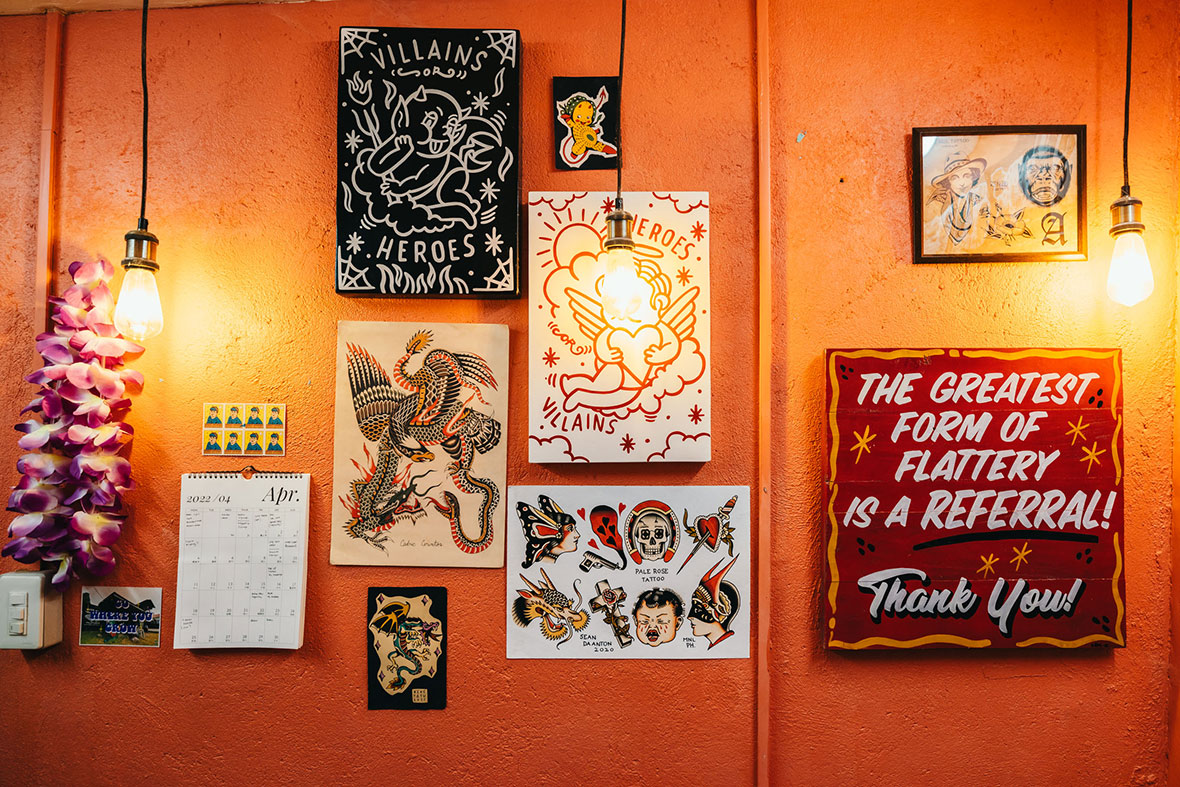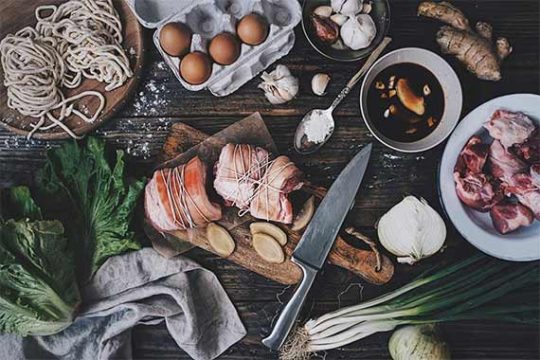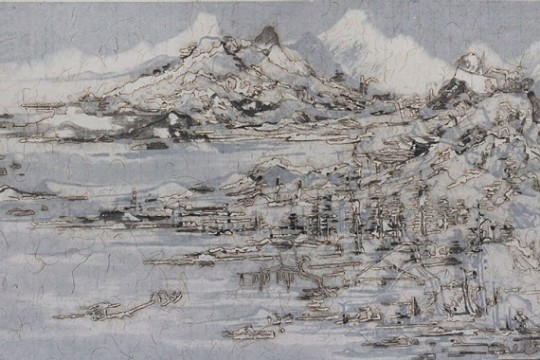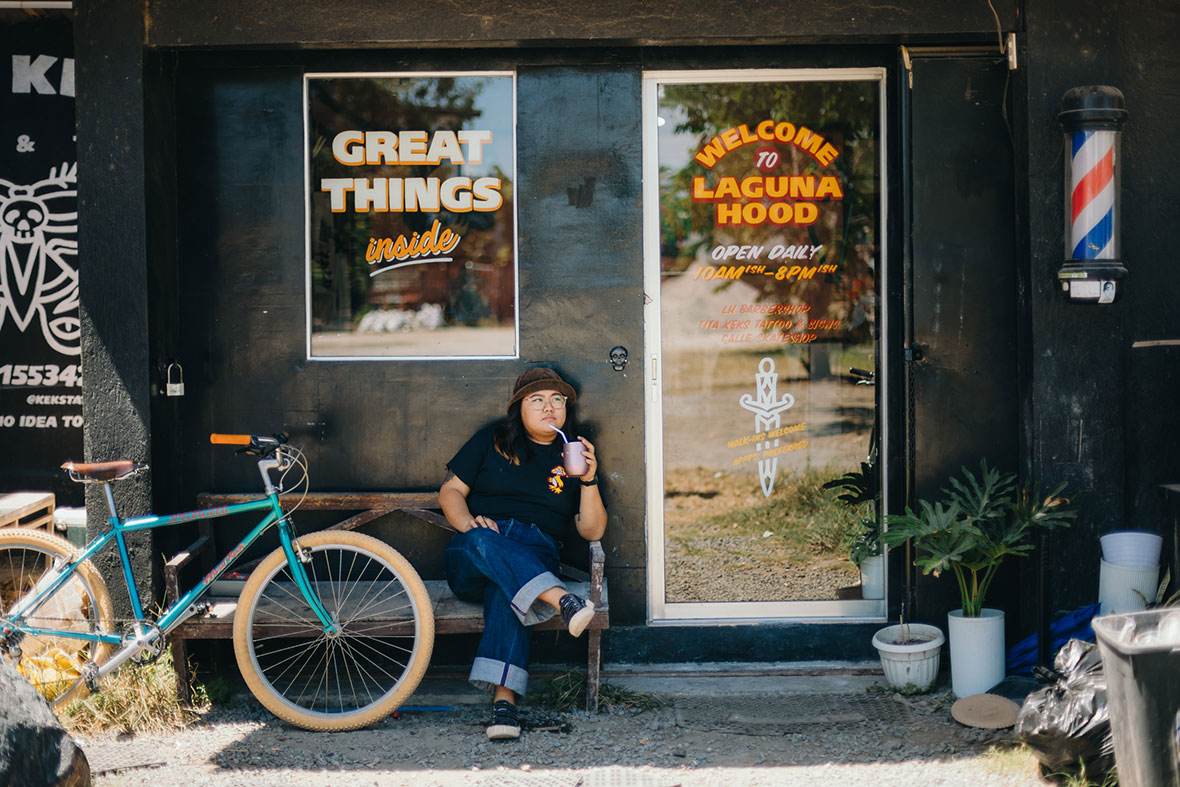
In an era of effortless reproduction, sign painting has become a lost art. In the Philippines, tarpaulins on small sari-sari stores with telecom brands printed in plain black letters are ubiquitous. It’s rare to find a shop with hand-painted letterwork. But there are still some holdouts that believe in a do-it-yourself approach, such as Jeepney signage or hand-drawn tubero posters advertising plumbing services plastered all over Manila. When Filipina artist Krizel Hidalgo decided she wanted to pursue sign painting, she didn’t realize she’d be one the few left doing it.
工厂流水作业,让时下的产品外观正在日渐趋同,商家二话不说,就给你来个原样照搬,这也使得纯手工制作正在渐渐消失在大众视野。在菲律宾,小卖部门头的柏油布招牌随处可见,这些浅底黑字的数字印刷品毫无特点可言,而纯手绘招牌却在街头寥寥无几。事实上,菲律宾当地仍有一帮人希望能把 DIY 精神践行到底,譬如吉普尼巴士、还有贴遍了整个马尼拉水泥电线杆的手绘维修告示等等。当菲律宾艺术家 Krizel Hidalgo 决定投身手工招牌绘写时,她并没有意识到这个行业已经没剩下几个人在做了。
Tita Keks is Hidalgo’s sign-painting and tattoo studio. Located in Laguna, a province just outside of Manila, it’s where she produces hand-drawn signs and posters, all of which are imbued with a playful sense of sarcasm. Her letters are vibrant and colorful, drawn with confident strokes and often involve several typefaces. These signs range from the cynical (“Rats get fat while brave men die”) to the motivational (“Be Who You Want To Be”) to the promotion of female pride and self-love (“Morena bombshell”).
手工招牌工作室 Tita Keks 由 Krizel 一手创立,其坐标拉古纳(Laguna),位于菲律宾首都马尼拉城外。在这里,Krizel 创作了大量手工招牌,其中大部分充满了玩讽的意味。她的作品大都鲜艳活泼,一笔一画显得自信满满,拥有各式各样的字体风格。其中不乏一些愤慨:“勇敢的人把老鼠们喂大(Rats get fat while brave men die)”、还有一些鼓舞人心的标语:“你可以成为任何人(Be Who You Want To Be)”、以及宣扬女性和爱的观点:“女中豪杰(Morena bombshell)”。
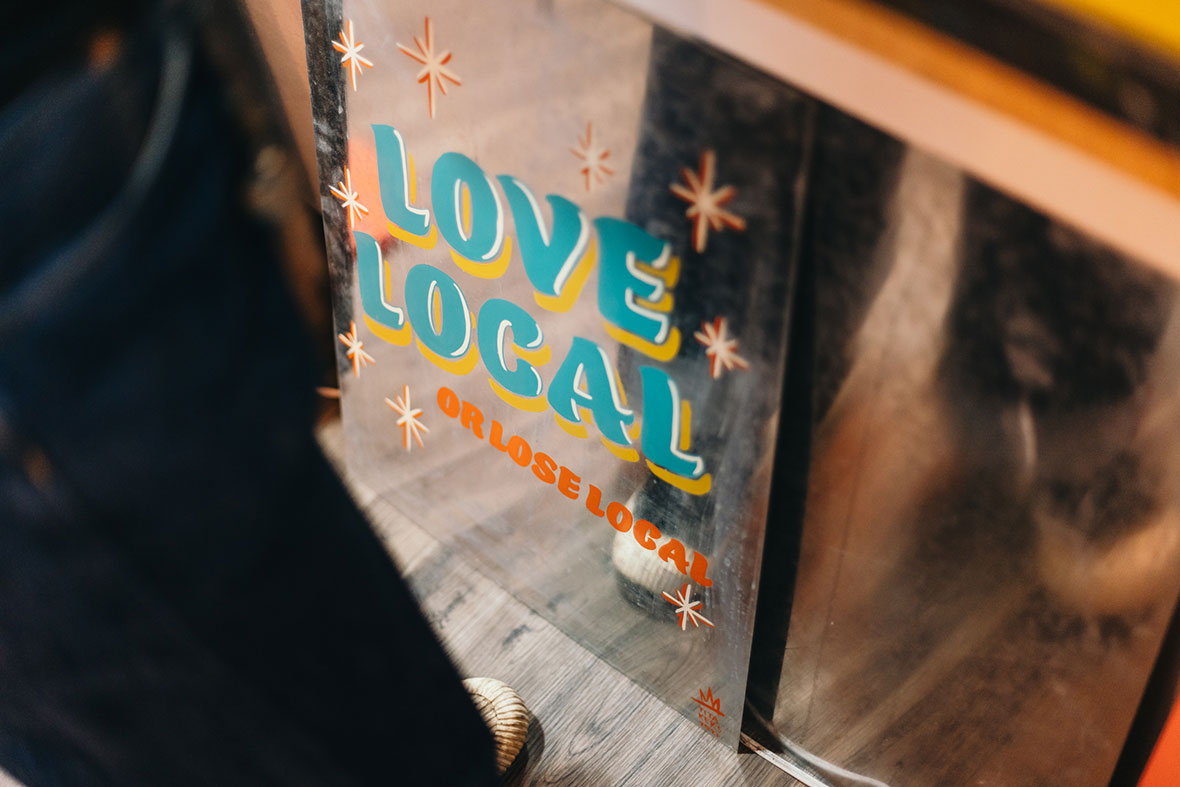
In addition to these personal pieces, she frequently works with local businesses, including other tattoo parlors, a record store, a barber shop, and more. Even when she’s doing client work, Hidalgo finds deep meaning in the needs of her customers. “When I’m painting, all I can think about the whole time is the person who’ll use it,” she says. “I really think that’s something important.”
除了个人作品,Krizel 还频繁参与商业机构合作,客户囊括了当地大大小小的纹身店、唱片店、理发店等等。而即便是商业项目,Krizel 也能出色拿捏客户内心的深层理念。她说道:“每当我创作的时候,我都会尽可能去揣摩观看者以及使用者的感受,这一点非常重要。”
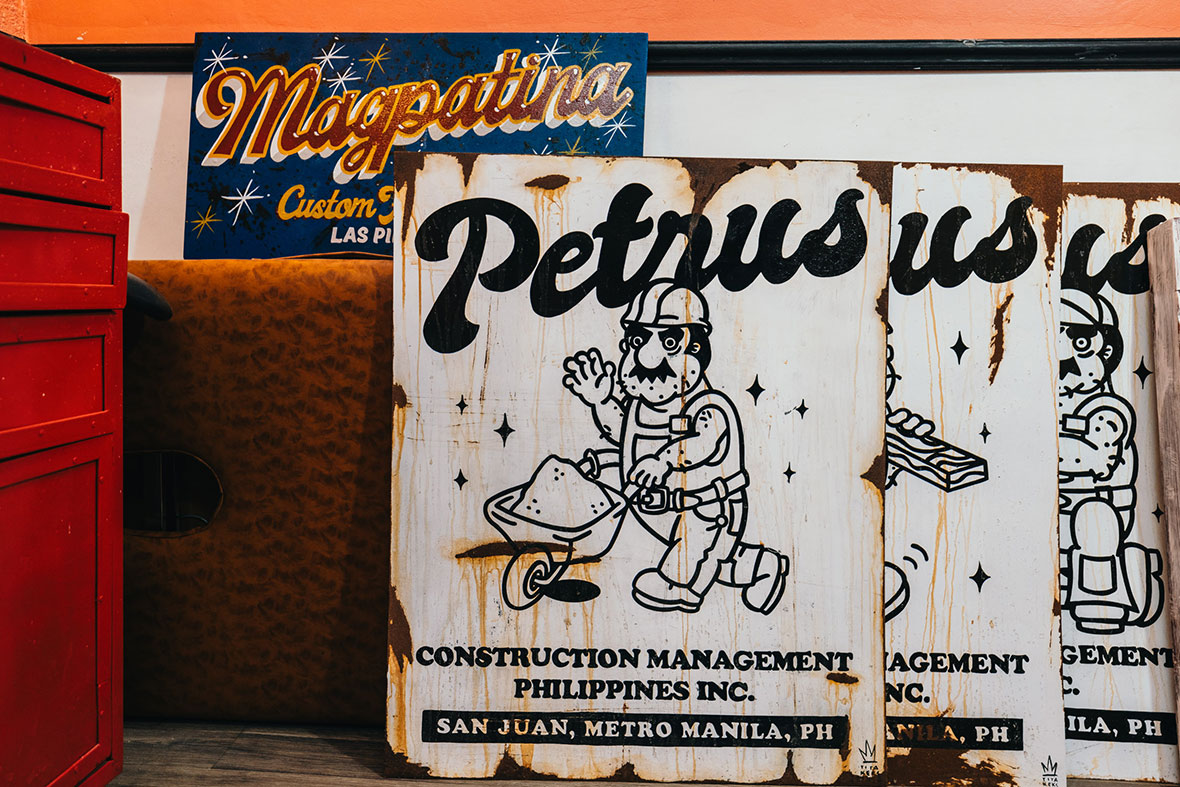
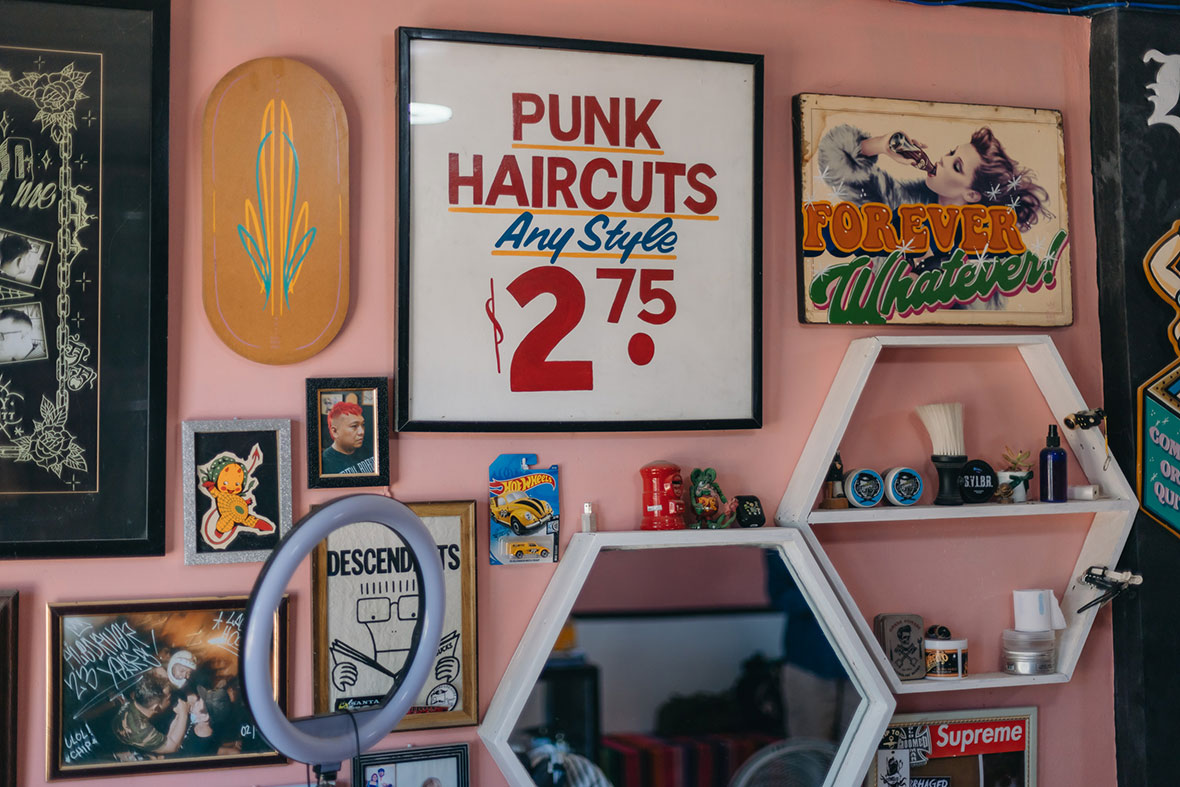
Hidalgo paints on a range of surfaces and materials, including metal and wood. Of all of them, glass has become her favorite, because of the challenges it poses. Relishing hurdles has been a constant theme in her creative trajectory. “Those frustrations made me fall in love with sign painting. It was so damn hard!”
When she first started drawing hand-painted letters, Hidalgo admits that she could barely paint in a straight line, let alone control the brush or mix the paint correctly. It was all even more difficult on glass. “It took me seven hours to paint my first glass sign!” she recalls. “The consistency of the paint has to be just right. You won’t find instructions or exact measurements on the internet; you just need to feel it. And you can only know that feeling if you’ve done it a thousand times. But once I got the hang of painting glass, it’s the easiest and the most fun surface to paint on.”
创作原材料的使用相当广泛,有时要用到金属、甚至木材。在所有这些材料中,Krizel 偏爱玻璃,但它对作品呈现来说是极大的挑战。而攻克一个个困难,却是她的一大乐趣。她说:“我喜欢创作中焦头烂额的感觉,太他妈刺激了!”
Krizel 回想起第一次创作手工招牌时,甚至不能完整地画出一道直线,她独自一人慢慢纠正、练习自己的笔法。而在玻璃上创作,让一切变得更难。她回忆道:“第一次在玻璃上画就用掉我七个小时!网上没有任何教学,就得自己慢慢来,去感受、体会,直到一千次之后才能掌握。一旦学会之后,创作就变得极其简单、并乐在其中。”
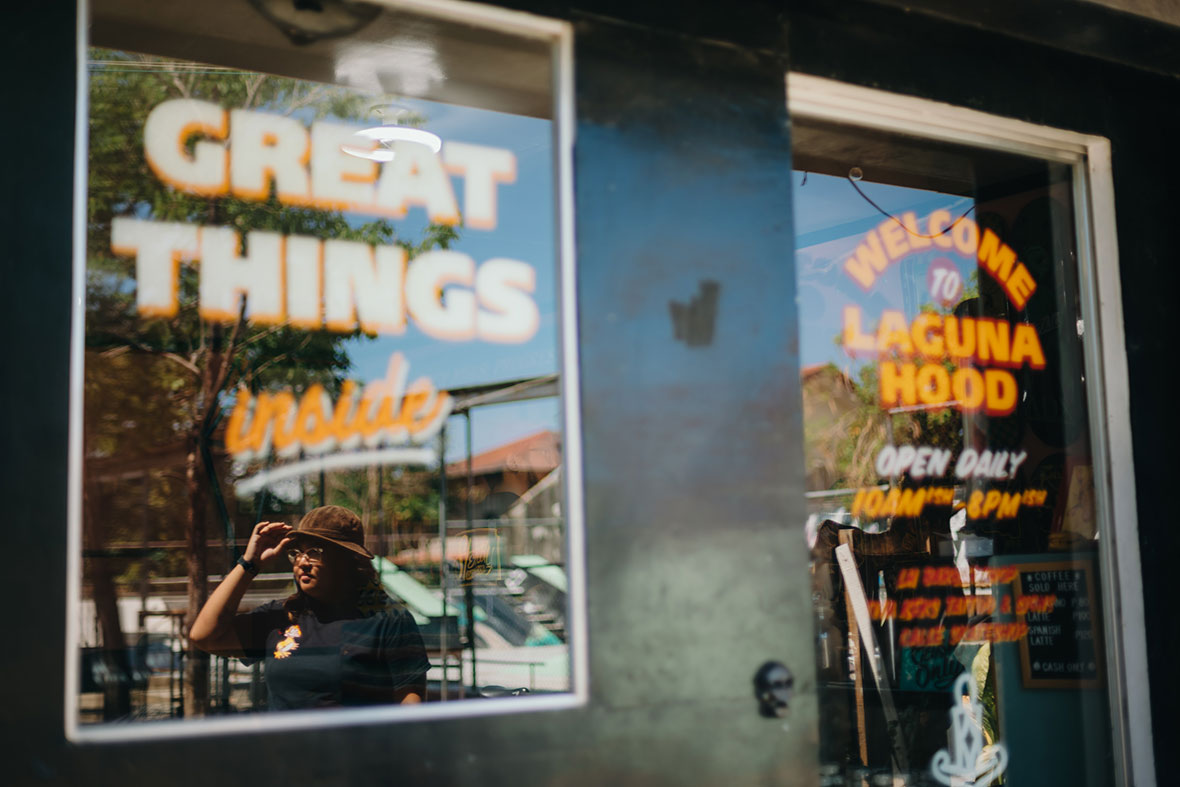
The overall learning curve was made that much harder by the fact that very few sign painters remain to learn from these days. “When I was starting, I tried searching online how to paint signs, but none of the videos made sense,” she says. “So I started messaging sign painters on Instagram from different countries to ask questions.” Hidalgo says a local named Kuya Vinz, who now builds bikes but used to be a sign painter, also offered help and advice.
手工招牌的学习比看起来要难得多,以至于很少有人能坚持下来。Krizel 说道:“我刚开始学的时候也会在网上查找一些视频教学,但没有一个靠谱的。于是我开始在 Instagram 私信大神,”她提到当地一位名叫 Kuya Vinz 的艺术家,此人目前正从事自行车组装,但曾也是一名招牌手画师,经常为她提供很多有用的建议和帮助。
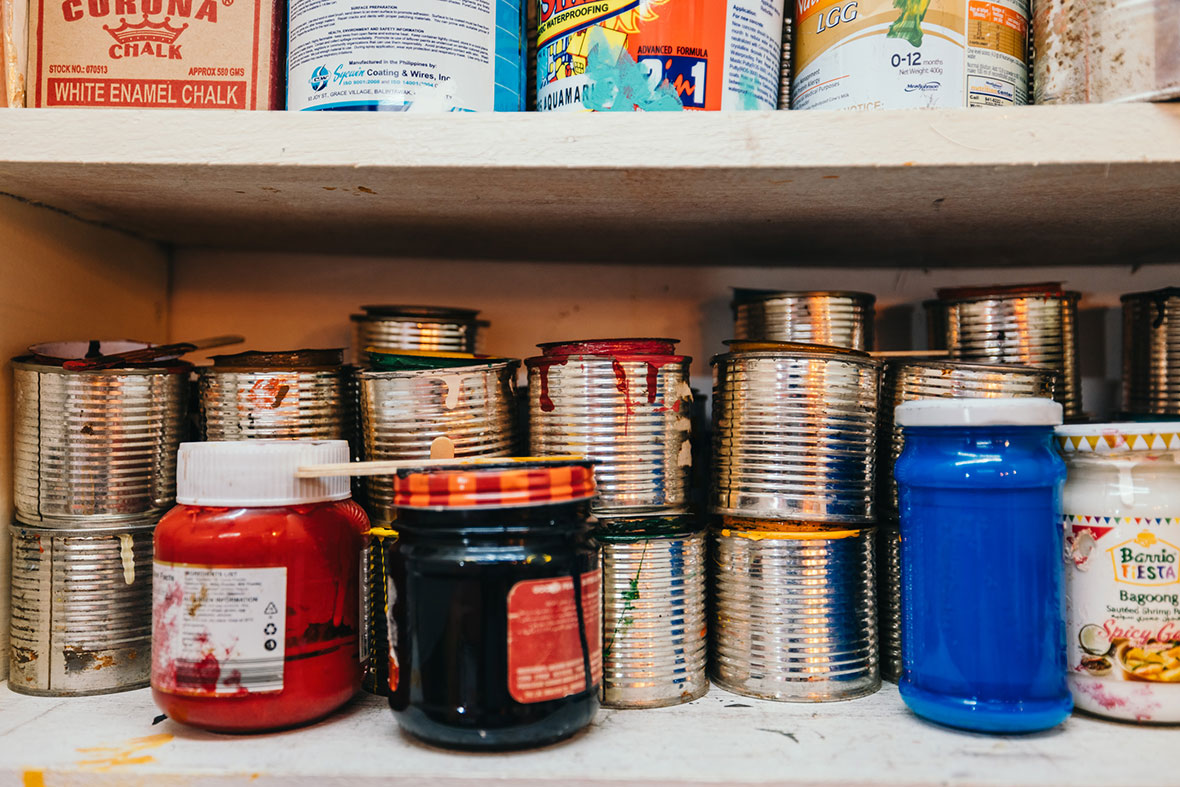
It’s difficult to buy sign-painting materials in the Philippines as well. Only one type of brush fit for sign painting is available in art stores, but even that isn’t fully ideal since it’s made of nylon. Lettering enamel is not available at all. Instead, Hildalgo asks friends in the Kustom Kulture community to make her brushes. (Kustom Kulture originally revolved around cars and motorcycles in California but has spread to every part of the world.) “I was into that scene way before I started sign painting,” Hidalgo says. “It’s a mashup of everything custom or hand made; there’s traditional tattooing, sign painting, pinstriping, choppers, hot rods, clothes, music… I love everything about it.” She also dabbles in traditional tattoos, which influence back to her sign-painting endeavors.
招牌的创作原材料在菲律宾很难买到。市面上仅有一种笔刷适合招牌创作,而当地业内人士却认为这种笔刷还不够理想,因为该笔刷的尼龙材质对瓷漆的吸附力不够。为此,Krizel 专门找到 Kustom Kulture 社区的人定做专用笔刷(加利福尼亚 Kustom Kulture 社群最初以汽车、摩托涂装闻名,并享誉全球)。她说道:“在从事招牌手绘之前我就很喜欢 Kustom Kulture,他们的纹身、装饰绘、手绘招牌、机车、热棒复古车、服装、音乐等等,简直棒呆了好吧。” 值得一提的事,Krizel 在平时除了进行手写招牌的工作,还是一名 old-school 纹身师。
Being able to keep a dying tradition afloat is one of the most rewarding aspects of sign painting for Hidalgo. In addition to persevering and mastering the technical skills, she also incorporates a wealth of local influences, including old-school movie posters, Filipino komiks, and even design inspiration from Pinoy ice cream carts. But she credits jeepney artists with building the foundation for Filipino sign-painting and doing the most to keep it alive. (Unfortunately though, jeepneys have started being replaced by impersonal, government-backed mini-buses.)
Embracing all of these local cultures, combined with international influences such as circus-inspired types and storybook fonts, results in a distinctly personal aesthetic with an explicitly Filipino flair. During a time when cheap, digital printing processes threaten to stamp out a lot of individuality and community heritage, this insistence on the human touch is all the more important. She says, “I think hand-painted signs have souls in them: They were made just for you.”
坚持一项逐渐消逝手艺,是难能可贵的事。而除了秉承工艺,Krizel 显然下了更大功夫。她从当地许多艺术形式汲取灵感,譬如复古的手绘电影海报、菲律宾漫画、甚至菲利宾的冰激淋推车外包装……在这些风格中来去自如。她称赞吉普尼艺术家们为手绘招牌的发展奠定了基础,并尽他们所能让吉普尼艺术发扬光大,但可惜的是,吉普尼巴士在前不久被当地政府取缔。
Krizel 在拥抱本土文化的同时,也与西方文化进行融合,比如复古马戏团宣传字体、图书封面等,这些元素呈现出她独具特色的一面。当廉价的数字打印正在侵蚀个性与文化遗产,人情味站出来作以抗衡。她说道:“手写的招牌因为是人来创作,所以更懂你;而且每一幅作品都没有重复,更像是为你量身打造的事物。”
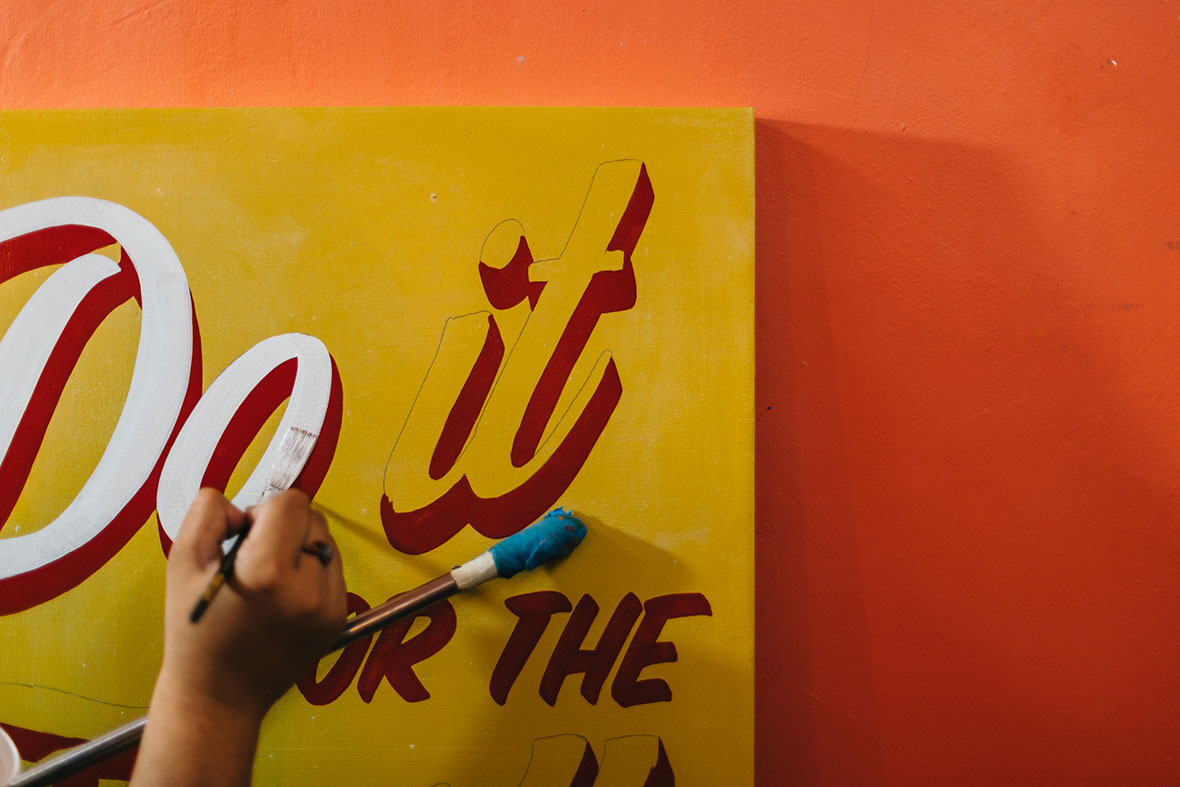
Like our stories? Follow us on Facebook and Instagram.
Instagram: @titakeks
Contributor: Mike Steyels
Photographer: Jilson Tiu
Chinese Translation: Pete Zhang

